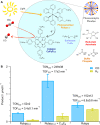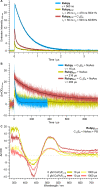Multi-Variable Multi-Metric Optimization of Self-Assembled Photocatalytic CO2 Reduction Performance Using Machine Learning Algorithms
- PMID: 38767460
- PMCID: PMC11157525
- DOI: 10.1021/jacs.4c01305
Multi-Variable Multi-Metric Optimization of Self-Assembled Photocatalytic CO2 Reduction Performance Using Machine Learning Algorithms
Abstract
The sunlight-driven reduction of CO2 into fuels and platform chemicals is a promising approach to enable a circular economy. However, established optimization approaches are poorly suited to multivariable multimetric photocatalytic systems because they aim to optimize one performance metric while sacrificing the others and thereby limit overall system performance. Herein, we address this multimetric challenge by defining a metric for holistic system performance that takes multiple figures of merit into account, and employ a machine learning algorithm to efficiently guide our experiments through the large parameter matrix to make holistic optimization accessible for human experimentalists. As a test platform, we employ a five-component system that self-assembles into photocatalytic micelles for CO2-to-CO reduction, which we experimentally optimized to simultaneously improve yield, quantum yield, turnover number, and frequency while maintaining high selectivity. Leveraging the data set with machine learning algorithms allows quantification of each parameter's effect on overall system performance. The buffer concentration is unexpectedly revealed as the dominating parameter for optimal photocatalytic activity, and is nearly four times more important than the catalyst concentration. The expanded use and standardization of this methodology to define and optimize holistic performance will accelerate progress in different areas of catalysis by providing unprecedented insights into performance bottlenecks, enhancing comparability, and taking results beyond comparison of subjective figures of merit.
Conflict of interest statement
The authors declare no competing financial interest.
Figures





References
-
- Bonchio M.; Bonin J.; Ishitani O.; Lu T.-B.; Morikawa T.; Morris A. J.; Reisner E.; Sarkar D.; Toma F. M.; Robert M. Best Practices for Experiments and Reporting in Photocatalytic CO2 Reduction. Nat. Catal. 2023, 6 (8), 657–665. 10.1038/s41929-023-00992-7. - DOI
-
- Fang S.; Rahaman M.; Bharti J.; Reisner E.; Robert M.; Ozin G. A.; Hu Y. H. Photocatalytic CO2 Reduction. Nat. Rev. Methods Primer 2023, 3 (1), 61.10.1038/s43586-023-00243-w. - DOI
-
- Kitchin J. R. Machine Learning in Catalysis. Nat. Catal. 2018, 1 (4), 230–232. 10.1038/s41929-018-0056-y. - DOI
LinkOut - more resources
Full Text Sources
Research Materials

